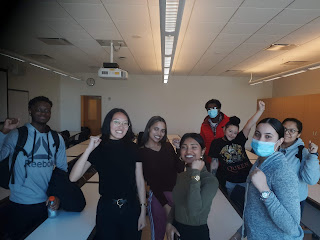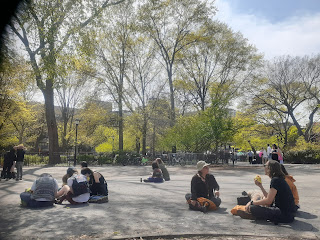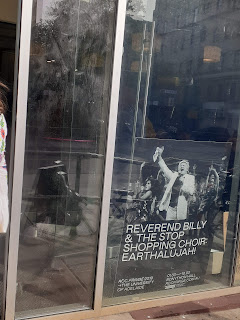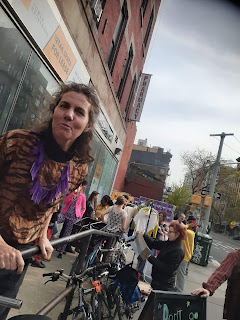Alice N Hu from New York Communities for Change came to talk to my class last week. She talked about her journey into the climate movement and intersectionality, connecting housing justice = climate justice. Each week, we’ve explored commonalities and intersections, ways our lives overlap, diverge and converge. We’ve read Coates and Melville, bell hooks and Audre Lorde. The students in our class wanted to hear about Alice’s history as an organizer, the reasons she’d been involved in direct action, her arrests, how it felt to get arrested, and how Hu helped
organized the demo a few of us were arrested at before climate week.
“I’m from Illinois,” said Hu. “There’s a lot less diversity there. And I never really imagined people made much more than what a college professor makes. When I got to New York a few years ago, I saw that NYC has a lot more inequality than I’d ever seen. A lot of people made a lot more than what college professors make. And a lot of people made a lot less. It's not fair. I started to learn about the Civil Rights Movement. Thank god they solved that, we thought. I saw there was more to it, more problems, no gay marriage, continuing racism and homophobia. THese were all issues that were important to me. My parents were immigrants and they said don't get into trouble. Immigrants usually don’t. I started interviewing people for an oral history about the counterculture and then about activism, hearing stories about creating something new, something vibrant. My oral history on interracial marriage opened my eyes to the importance of intersectionality. Gay marriage would not have been possible without civil rights activists, who fought for interracial marriage,” specifically Loving vs Virginia, the 1967 Supreme Court decision, overturning laws against interracial marriage. When Hu moved to New York, she wanted to keep her work going, working with activist groups, organizing with unions. She seemed to understand how tenuous our victories are and the work needed to push things forward.
Speaking about gay marriage and queerness, Hu referred to ACT UP, my favorite group.
It was a place to be who you really are.
That’s part of the goal of all of this, to find a place on this earth.
This was a place where a lot of us came out as who we really were, art.
Hu asked about my experience with ACT UP. We talked about Reagan basically failing to even say the word AIDS for the first seven years of his administration. Not until members of ACT UP started waves of civil disobedience, sieging the National Institute of Health, storming the FDA, did the federal government start responding or moving on AIDS. AIDS activists were theater people, as the civil rights people had been. They saw the theatrics of a good demo.
“I got a job as an activist,” said Hu. And started feeling the eco anxiety, recognizing that things were going to get worse by 2030, 2050. More floods, more food scarcity, especially people in island communities on coasts and floodplains. I organized workers on campus and with Planned Parenthood. I started looking for more of an involvement with climate justice related work. I found a group called Extinction Rebellion. Their whole point was that big wins - the right to vote, civil rights, Indian civil rights, etc - come from mass civil disobedience efforts.
Climate, like AIDS, was ignored, said Hu, connecting the dots between movements. XR was blocking bridges, disrupting parliament, and getting the government to take notice.
Cop25, the main climate conference in the world, was taking place in Madrid, Spain in 2019. I was there for the year. Someone encouraged me to get involved. Like ACT UP, it was theatrical. So I jumped in. I was standing on ice blocks slowly melting. This was theater. And we got arrested, well, the cops pulled us away finally, fake arrested. But unlike other demos, this felt powerful, said Hu. Power was growing exponentially. “We run intersectional campaigns, that hit at intersections of people’s lives, a roof over head, and new clean units,” that fall under the guidelines of the Climate and Community Protection Act and the Paris Climate Goals. Can we reduce emissions and build 100% green, affordable units?
We are all navigating these changing times.
In the class, the students and I read portions from “Traveling Theory,” an essay by Edward Said. He writes:
“Theory… is won as result of a process that begins when consciousness first experiences its own terrible ossification in the general reification of all things under capitalism; then when consciousness generalized (or classes) itself as something opposed to other objects and feels itself as contradiction to (or crisis within) objectification, there emerges a consciousness of change in the status quo, finally, moving toward freedom and fulfillment…”
We are all moving through those contradictions into something new, those waves crashing to and from inside us.
Moving through the texts and stories,
Alice’s talk reminded me of the sense of abundance we feel when we build our power collectively, when we speak out for what's right, fight back against injustice and find something better together.
That feeling followed me all week.
It was there singing with friends on Sunday at Marie’s crisis, on Saturday with the tambourine at Norm and Karina’s.
It was there, reading about the anniversary of the riots of 1992, April 29, a week before I graduated from college.
I know my story of the riots… watching it unfold in Claremont, zipping around Los Angeles, on the 10, listening to Straight outta Compton, watching smoke rise in the distance, the flames...the streets... the bodies pouring out into them...people ripped from there cars, violence, flames, the critique of inequality...the feeling...
They were an eye opener like few others, those riots of April 29, 1992, thirty years prior.
The little one and I rode up to Valentino Pier in Red Hook on Saturday morning, passing the cat sanctuary, finally arriving, sitting along the water looking out.
“This space is parks right,” they asked, laying in the grass, looking at the rocks and water, waves moving to and from, Statue of Liberty in the distance.
“Yes, it's a public park,” I replied. It's safe, as far as I know.
“Phew,” they replied.
It's not going to be developed, not like East River Park or the Gowanus, where alleys and baseball areas, the Gowanus Cat sanctuary, their childhood meeting spaces are being fenced off and bulldozed for redevelopment.
“I’ve thought of what I’m doing my presentation on. A highway ran through their world in Hitchhiker's Guide the the Galaxy,” they related. “I’m going to compare that to Robert Moses’ highway through the South Bronx, destroying neighborhoods, and his attempt to one through Washington Square Park.”
In the Hitchhikers Guide, Addams explains:
“There is a theory which states that if ever anyone discovers exactly what the Universe is for and why it is here, it will instantly disappear and be replaced by something even more bizarre and inexplicable. There is another theory which states that this has already happened.”
Sometimes I feel like that's already happening.
It's odd looking at a city at war with trees.
“Many were increasingly of the opinion that they’d all made a big mistake in coming down from the trees in the first place,” writes Adams. “And some said that even the trees had been a bad move, and that no one should ever have left the oceans.”
Progress is anything but certain.
Today it feels perilous, I think, looking at the water ebb to and fro, talking with the teenager about cities changing, cat sanctuaries destroyed, displaced by development projects, highways running through neighborhoods, as they had in the book, as they had in New York, destroying worlds to make way for progress watching the Brooklyn tides. It's the New York rite of passage to lose parts of what your neighborhood was. Flux is constant.
Tim was uptown, eating lunch when I dropped by, ALS still robbing him of words.
But we still greet each other.
I love you i say.
He types back.
Each day, it feels more distant.
Outside, I stroll past the cathedral on 1047 Amsterdam Avenue, St John the Unfinished.
So much unfinished.
Tim is certainly unfinished.
Mom was looking at her flowers when I arrived 90 minutes later.
These are in bloom.... she says, pointing to the late bloomers and lilacs in her beloved garden.
May is for tambourines.
I’ve often felt this way.
And Saturday was no exception.
Day by Day, we sing from Godspell, my tambourine shaking at Norman and Karina’s cabaret later that night.
“Oh Dear Lord / Three things I pray / To see thee more clearly / Love thee more dearly / Follow thee more nearly ..."
It's a song we always sing at Judson, where we talk about it all, workers and tiny prayers, mediations and songs, and Broadway mixes with all spirituality and embodied poetics.
The modern testimony is “The Peace of Wild Things” by Wendell Berry:
“When despair grows in me
And I wake in the night at the least sound
In fear of what my life and my children's lives may be,
I go and lie down where the wood drake
…Waiting for their light. For a time
I rest in the grace of the world, and am free.”
Hopefully we can feel free.
I guess that's the challenge.
Mayday is jay day...I think, walking out of the services,
smelling the pot in the air in Washington Square Park, on the way from Judson,
international workers day, a day to celebrate and be angry, says Barbara Bowen, the consummate union leader of this era. It's a time to thank workers for our free time, for our rights, for the eight hour work day, a time to recall Sacco and Vanzetti, immigrant anarchists, accused of murderiApril 15, 1920, and the Haymarket Martyrs, whose death inspired Emma Goldman to grieve, compelled her to action, to remember the countless others lost. Solidarity forever. ... to beat back miserablism and find ourselves ... with others workers...other comrades.
Friends from everywhere, Bobby from LESC, Carolyn from reading groups passed and future, were on hand.
Off I ride to Union Square for more, and then to Le Petit Versailles....where Pee Wee had invited people to the queerest of community gardens for their annual Mayday ritual.
“We ‘re moving forward to return Beltane celebrations to Le Petit Versailles . You are invited. 12-3pm for general cavorting over coffee,decorating pole and ribbon making. Maypole prancing and ritual after 3pm as the crow flies and we settle into more reverie.
Bring your best offering and intentions cuz this is a LOVE thang!”
People hug when I arrive, May poles and ribbon making in the in between garden.
I need a minute to stop, parking at Tompkins with a slice of pizza, sitting by the old Gaia Tree, where @pinclouds were just beginning a show in the park.
Their shows have been a bit of a sanctuary for queer kids, actually for everyone attending them.
Open to all in Tompkins or La Plaza Cultural, they’ve given us a chance to laugh and feel connected.
All over the park, friends are meeting.
Elissa is there with puppet in hand.
I’m not sure I am in the best position to give legal advice, notes her puppet, chatting with me about our visa woes around Italy and Prague and Berlin.
Peter is selling spinach at the farmer’s market,
Colin chatting about writing.
Bear is on hand with buddies, dancing about.
So are Allie’s kids.
And Chris Ryan is telling me about his movie about Choking Victim.
He posted:
“Amazing summer-like day in Tompkins - ran into endless Friends and characters from life and music, Art, storefront takeovers - a rebirth of the good ole days elements of the bad ole days.”
On we walked to Ave C to catch the Rev Billy show.
Incredible heartfelt show with @revbillytalen and @savitrid.nyc recalling lost trees and an earth defender consumed by despair, gone too soon. It's not easy when we lose parts of the city and ourselves. So we sing ... and pray for the dead... and fight for the living.
Back in Brooklyn, Al met me on Fulton.
I have this vision of a Gaudi ending said Al, tired from his walk over, chatting over seltzer water and pints of beer, recalling the demise of the architect in the streets of Barcelona, who perished “on the 10th of June 1926 after being knocked down by a tram…After being struck he lost consciousness, and nobody suspected that this dishevelled old man who was not carrying any identity papers was the famous architect”
The last time Al saw Ornette Coleman play was at the Town Hall concert of 1962. I saw him play in Umbria and San Francisco thirty years years ago. Tonight we saw his son reprise the 1959 Shape of Jazz to Come at BAM, channeling Stravinsky and Coltrane and the ghosts of bebop.
Another day in the life.
Mayday is jayday.
Good days, bad days.
Contradictions run through us as our consciousness shifts and evolves.
Maybe that was Alice’s point.
I guess that's what May Day is all about.





























































































No comments:
Post a Comment